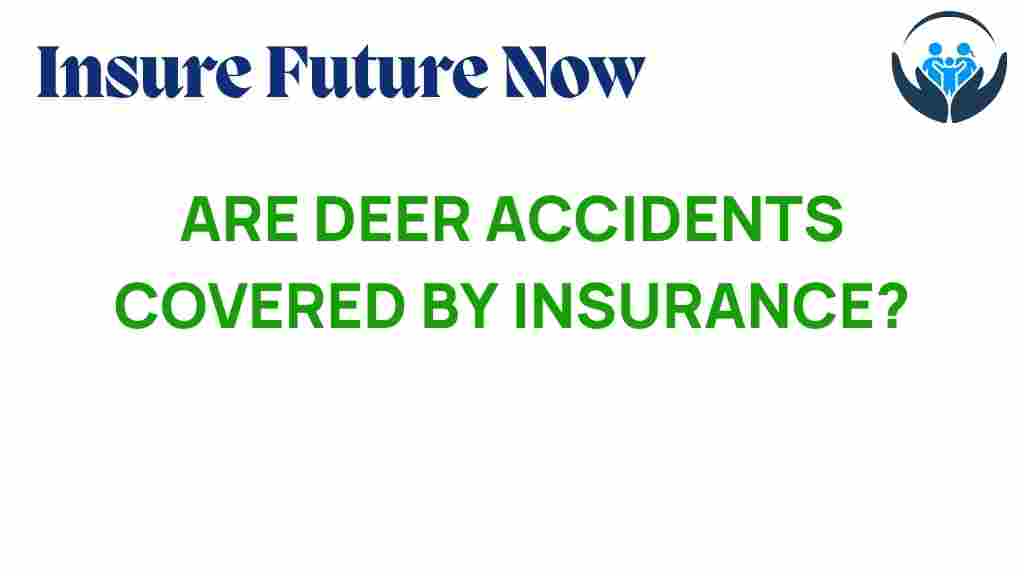Are Deer Accidents Covered by Insurance?
Deer accidents are a common concern for many drivers, especially in rural areas where wildlife crossings are frequent. Understanding whether your insurance coverage includes deer accidents can help you navigate the aftermath of such incidents. In this comprehensive guide, we will explore the relationship between deer accidents and car insurance, the claims process, policy details, and how to ensure driving safety to minimize your risk of wildlife collisions.
Understanding Deer Accidents and Insurance Coverage
Deer accidents, also known as wildlife collisions, occur when a vehicle strikes a deer. These accidents can result in significant damage to your vehicle, injury to drivers or passengers, and even fatalities. Therefore, it is crucial to know how your car insurance policy handles these situations.
In general, deer accidents are covered by comprehensive car insurance policies. Here’s what you need to know:
- Comprehensive Coverage: This type of insurance covers damages caused by events other than collisions, including theft, vandalism, and wildlife collisions.
- Collision Coverage: If you have collision coverage, it may also cover deer accidents, but this typically applies if you hit the deer while avoiding another vehicle or object.
- Liability Coverage: This coverage does not apply to deer accidents, as it only covers damages you cause to other people or their property.
Step-by-Step Process for Filing a Claim After a Deer Accident
If you find yourself in a deer accident, following a systematic claims process can help ensure you receive the compensation you need. Here’s a step-by-step guide:
Step 1: Ensure Safety First
After an accident, your safety and the safety of your passengers is the priority. Check for injuries and move to a safe location if possible.
Step 2: Call the Authorities
Contact local law enforcement to report the accident. This is important for legal documentation and may be required by your insurance company.
Step 3: Document the Scene
Take photographs of the accident scene, including:
- The damage to your vehicle
- The location of the accident
- The deer, if possible
- Any road signs or environmental factors
Step 4: Gather Information
Collect information from any witnesses and the responding officers. Make sure to note the police report number and any other relevant details.
Step 5: Contact Your Insurance Company
Report the accident to your insurance provider as soon as possible. Provide them with the accident details, photos, and any other documentation you’ve gathered.
Step 6: Review Your Policy Details
Examine your car insurance policy to understand what coverage you have. Look specifically for sections on comprehensive coverage and wildlife collisions.
Step 7: Follow the Claims Process
Your insurance company will guide you through their specific claims process. Be prepared to provide additional information or documentation as requested.
Understanding Policy Details Related to Deer Accidents
When reviewing your car insurance policy, pay close attention to the following details:
- Comprehensive vs. Collision Coverage: Verify which type of coverage applies to deer accidents in your policy.
- Deductibles: Understand how much you will need to pay out of pocket before your insurance kicks in.
- Limits of Coverage: Know the maximum amount your insurance will pay for damages related to a deer accident.
- Exclusions: Be aware of any exclusions in your policy that might affect your claim.
Driving Safety Tips to Avoid Deer Accidents
While understanding insurance coverage is essential, prevention is always better than cure. Here are some driving safety tips to reduce the likelihood of deer accidents:
- Stay Alert: Be extra vigilant in areas known for deer crossings, especially at dawn and dusk when deer are most active.
- Reduce Speed: Lower your speed in high-risk areas to increase your reaction time.
- Use High Beams: When appropriate, use high beams to illuminate the road better, but remember to switch to low beams when another vehicle approaches.
- Watch for Deer Crossing Signs: These signs indicate areas where deer are frequently spotted.
- Don’t Swerve: If a deer suddenly appears in your path, it’s usually safer to brake firmly and remain in your lane rather than swerving, which can lead to more severe accidents.
Troubleshooting Common Issues After a Deer Accident
Even after taking precautions, accidents can still happen. Here are some common issues you might face after a deer accident and how to address them:
Issue 1: Delayed Claims Process
If your insurance claim is taking longer than expected, consider the following:
- Contact your insurance adjuster for updates.
- Ensure all required documentation has been submitted.
- Remain patient, as claims can take time due to investigations.
Issue 2: Disputed Claims
If your insurance company disputes your claim, you can:
- Request a detailed explanation for the denial.
- Provide additional evidence, such as photographs or witness statements.
- Consider seeking assistance from a claims advocate if needed.
Issue 3: Vehicle Repair Complications
If you face delays in vehicle repairs, consider these options:
- Discuss rental car coverage with your insurance provider.
- Stay in contact with your repair shop for updates.
- Keep copies of all repair estimates and communications.
Conclusion
Deer accidents can lead to significant damage and distress, but understanding your insurance coverage can alleviate some of the stress involved. Always ensure you have the right type of car insurance that covers wildlife collisions, and familiarize yourself with the claims process to navigate any accidents smoothly.
By following driving safety tips and being proactive in understanding your policy details, you can minimize the risk of deer accidents. Remember, it’s always better to be prepared and informed. For more information on wildlife collisions and how to protect yourself, visit this resource.
Stay safe on the roads, and drive responsibly to avoid accidents with deer and other wildlife!
This article is in the category Claims and created by InsureFutureNow Team
